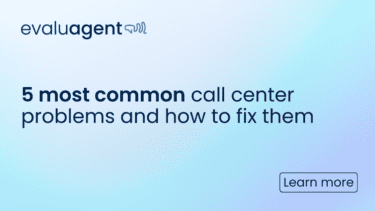5 most common call center problems and how to fix them


Managing a call center is a complex undertaking that requires a delicate balance of many variables – from technology and processes to human resources and customer relationships.
Most call centers are fast-paced and dynamic, handling various calls across multiple departments or clients. Minor issues can quickly escalate, affecting both customer satisfaction and the center’s operational efficiency.
That’s why it’s critical to identify issues and develop proactive, long-term solutions.
Here are the most common call center problems and how to solve them.
Few things deter customer satisfaction more effectively than prolonged wait times on a call. While some wait is perhaps inevitable, particularly in peak hours, there are fine lines between tolerance and frustration.
Surveys show that 23% of callers feel waiting times are too long, and 52% expect a swift resolution. In some cases, extraneous waits can lead to unresolved calls and escalating customer issues and complaints.
Moreover, longer wait times also mean that agents are potentially overloaded, triggering stress and reducing performance and job satisfaction.
Effective queue management is paramount to tackling long wait times.
Modern call center software often includes smart algorithms designed to prioritize and distribute incoming calls before anyone has to pick up the phone.
By automatically directing calls to agents based on the department required, the agent’s expertise, and the nature of the customer’s enquiry, call queue systems reduce wait times while improving first call-resolution rates.
Long wait times are compounded by low first-call resolution rates.
First-call resolution is vital in assessing a call center’s efficiency and customer service quality.
When customers need to make multiple calls to resolve a single issue, it leads to frustration and eats into the call center’s resources.
Repeated calls for the same issue indicate a systemic problem that must be addressed.
Call center quality assurance analysis via powerful third-party platforms is your ticket to improved resolution rates, which lightens the burden on the entire call center.
Consider implementing real-time support systems to assist agents during live customer interactions to enhance first-call resolution rates.
Features like instant access to customer histories, on-the-spot coaching, or even AI-based recommendation engines can help agents handle queries more effectively during the first interaction.
The ultimate aim is to save time and resources, and elevate customer satisfaction.
Constant issues and frustration lead to drops in employee wellbeing and, ultimately, increased turnover.
Employee attrition is a multifaceted issue that severely impacts call center performance.
Stats show that employer turnover is increasing, reaching 38% in 2022. High attrition rates are associated with the costs of continually recruiting, onboarding, and training new staff.
Attrition is a relentless drain on resources, but the financial impact is only the tip of the iceberg.
Consistent turnover also hampers service quality, causing inconsistencies that customers pick up on.
This, in turn, impacts customer loyalty and the overall reputation of the call center and the businesses it represents.
Fundamental to retaining employees is enhancing employee engagement and recognition.
A performance metrics system equipped with advanced analytics can deliver nuanced insights into individual and collective performance.
Not only does this enable managers to identify and reward top performers, but it also highlights those areas requiring intervention.
Progress statistics and gamified leaderboards can further help empower and retain agents for the long term.
This can also inform managerial decisions about agent career advancements, bonuses, and skill-building training or feedback.
The previous points are all symptomatic of an under-optimized workforce – one of the most draining problems in a call center.
If agents are too idle or stretched too thin, it leads to decreased productivity, diminished job satisfaction, and increased operational costs, to name a few.
Optimizing your workforce starts with rigorous performance management and targeted training initiatives.
Employ advanced analytics to monitor KPIs, such as call duration, customer satisfaction scores, and first-call resolution rates. One-to-one coaching can assist managers in delivering training on the fly.
With this data, you can identify performance bottlenecks, skill gaps, and training needs, allowing you to customize training programs accordingly.
Doing so improves agent performance and enhances job satisfaction, creating a more harmonious and productive work environment.
Technical issues are an unpredictable aspect of call center management that can be reduced to virtually nil but never entirely eliminated – even if all the above are in place.
From minor glitches in software applications to major server outages, technical roadblocks can grind operations to a halt, leading to customer dissatisfaction, revenue loss, and increased operational costs.
Over 60% of serious outages lead to business losses of over $100,000, and for Fortune 500 companies, losses might total an eye-watering $1 million per hour.
Investing in robust disaster recovery plans is a necessity. Employ data analytics tools to assess vulnerability, pinpointing the weak links in your technology infrastructure.
This extends to cybersecurity, as outages may be caused by hacking or ransomware attempts.
By identifying weaknesses, you can craft a comprehensive disaster recovery plan that reduces revenue loss and reputational damage in the event of unplanned downtime.
Learning how to fix problems in a call center requires a comprehensive management solution that addresses everything from employee engagement to performance monitoring, compliance, and optimization.
By investing in the right tools, you’re solving problems, better-assisting customers, and proudly representing brands and businesses. Modern call centers demand modern solutions, which is why effective call center management tools like EvaluAgent are now a necessity.